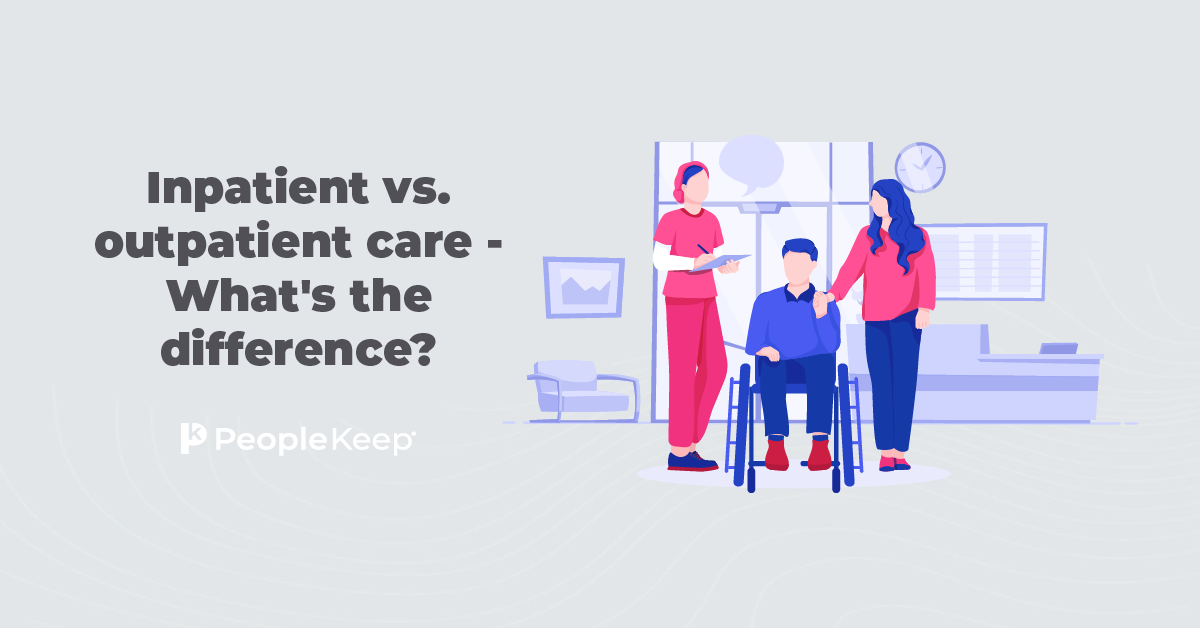What does out-of-network provider mean?
By Elizabeth Walker on May 29, 2024 at 8:30 AM
As medical costs continue to rise across the U.S., more healthcare consumers are seeking ways to save. And while you may not be able to control many factors that impact your healthcare costs, you can understand whether the physician you choose is “in-network” or “out-of-network”.
In this article, we’ll explain what out-of-network providers are, including how they compare to in-network providers, and show you how a health reimbursement arrangement (HRA) from your employer can help you cover your out-of-network medical expenses.
Takeaways from this blog post:
- Out-of-network providers don’t contract with health insurers to provide services at a negotiated rate.
- Out-of-network providers can cost more for insured individuals because their carrier may cover a smaller portion of their billed services or not cover the services at all.
- Health reimbursement arrangements (HRAs) can help cover out-of-network provider costs by providing tax-free reimbursements for qualified out-of-pocket medical expenses.
What is an out-of-network provider?
Out-of-network providers are healthcare professionals and medical facilities that don’t have a contract with a particular health insurer and, therefore, don’t have to provide care to individuals covered by that insurer at a pre-negotiated rate. Patients who receive out-of-network care will typically pay the full amount for health services, which can result in costly surprise medical bills.
The following are a few reasons why you may have to visit an out-of-network provider:
- You have a health emergency: If you need emergency care, you often visit the closest facility. The Affordable Care Act (ACA) requires all health insurers to cover emergency services even if you go to out-of-network facilities.
- You need to see a specialist: If you need specialized treatment for a specific health issue, you may have to visit an out-of-network specialist if the physician you need isn’t in your network.
- You can’t risk changing providers: Sometimes, your insurance provider may drop an in-network provider while you’re receiving necessary treatment. If this is the case, you may want to stick with the provider—even though they’re now out-of-network—so you can keep receiving consistent and continuous care.
- You’re on vacation: If you’re traveling and need medical care, you’ll likely have to see an out-of-network provider. Before you travel, check your health plan details to see if your insurer offers out-of-network coverage while you’re out of town.
- You live in a rural or remote area: Depending on your ZIP code, you may have a limited number of in-network providers in your area. In these cases, going to an out-of-network provider to receive prompt care can be your best option.
There are many reasons why your preferred provider may be out-of-network. A common reason is that your provider hasn’t accepted your insurer’s negotiated reduced rate. In other cases, the health insurer may want to keep their network small for greater leverage during negotiation. You can ask your insurance company to add your preferred provider to their network. However, they aren’t obligated to do so.
Your health insurance company will list its in-network providers on its website. Some insurers will even list out-of-network providers. If you’re unsure whether a medical provider is in or out-of-network, call your insurer for more information.
How do out-of-network providers compare to in-network providers?
In-network providers contract with a health carrier to provide policyholders with medical care at a negotiated and reduced rate. Because in-network providers can’t charge more than the pre-negotiated rate for covered services, patients pay less overall and receive fewer surprise healthcare bills.
Going through your provider network guarantees that your out-of-pocket costs, like copayments or coinsurance, will count toward your policy’s annual deductible and out-of-pocket maximum. In many cases, the amount you pay for out-of-network care doesn’t apply to your deductible or out-of-pocket maximum.
Why do out-of-network providers cost more on average?
In-network providers offer reduced rates to policyholders covered by a particular insurer to encourage them to get care from their facility. However, out-of-network providers aren’t subject to the same terms. Even if you just need routine care, you can wind up paying thousands of dollars in medical bills if you choose an out-of-network provider over an in-network doctor.
The following are three reasons why out-of-network providers may cost more:
- You're likely to pay full price: Your insurer can’t control what you’ll pay for healthcare services without a contract with the out-of-network provider. This means you’ll likely pay the full cost for the service, which is sure to be higher than a negotiated rate.
- You’re subject to balance billing: Even if your health plan agrees to pay a portion of your out-of-network care, many plans cap the highest amount they’ll pay for a particular service. If the out-of-network provider charges more than your plan will pay, you must pay the difference. This practice is known as balance billing.
- Your cost-sharing amounts may be higher: Because you’ll likely pay full price for your out-of-pocket services, you won't be responsible for a copay. However, you may have to pay the coinsurance percentage for out-of-network services for your policy, which will be higher than your in-network coinsurance percentage.
It’s best to visit an in-network doctor to save on out-of-pocket costs. But if you have to use an out-of-network provider, check if your plan covers a portion of out-of-network services in advance. You can also negotiate a lower medical bill with the provider.
Do health insurance plans cover out-of-network services?
Health insurers determine whether their plans will cover out-of-network services and, if yes, what percentage of the services they’ll pay for. However, plans like health maintenance organizations (HMOs) and exclusive provider organizations (EPOs) generally don’t cover out-of-network services unless the visit is to treat an emergency. Outside of emergency situations, the policyholder must pay the full amount for the service.
If you have a preferred provider organization (PPO) or point of service (POS) plan, your insurer may cover a portion of the cost for out-of-network services. But even so, you’ll pay more out-of-pocket than if you had gone to an in-network provider. These plan types typically have higher premiums and deductibles as well.
Due to the No Surprises Act of 2022, out-of-network providers can no longer balance bill you for emergency care. Depending on your plan, you may have to pay a copayment or coinsurance, but the cost for your emergency visit will be at your set in-network rate. If you received a non-emergency service, you’ll have to pay the full out-of-network cost.
The No Surprises Act also offers balance billing protections from out-of-network providers who treat you at in-network facilities. For example, if you receive care from an out-of-network surgeon at an in-network hospital, you won't receive an out-of-network bill from the surgeon.
How an HRA can help you cover out-of-network provider costs
Whether you seek care from an in-network or out-of-network provider, both will likely result in a certain amount of out-of-pocket expenses. Luckily, you can cover these costs with an HRA.
An HRA is an IRS-approved health benefit that allows you to receive tax-free reimbursements from your employer for out-of-pocket medical costs, like prescription drugs, doctor visits, surgeries, emergency services, and more. Depending on the type of HRA, your individual health insurance premiums may also be eligible for reimbursement.
HRAs are simple. Your employer gives you a monthly allowance to pay for medical costs. Unlike health savings accounts (HSAs), only employers can contribute to an HRA. Once you buy an eligible service or item and submit proof of purchase, your employer reimburses you up to your allowance.
HRAs are employer-owned, so you can’t keep the funds if you leave your company. If your employer administers your HRA with PeopleKeep, your unused funds won’t roll over annually; however, they’ll roll over monthly.
The following are three popular types of HRAs:
- The qualified small employer HRA (QSEHRA): A QSEHRA is an excellent option if your employer has fewer than 50 full-time equivalent employees (FTEs). QSEHRAs have maximum annual contribution limits; however, there are no minimum limits. All W-2 employees are automatically eligible for the benefit. However, you must have a plan with minimum essential coverage (MEC) to participate.
- The individual coverage HRA (ICHRA): An ICHRA works similarly to the QSEHRA, but it’s for employers of all sizes and has no minimum or maximum contribution limits. You can opt-in or out of an ICHRA, depending on affordability. But if you opt-in, you must have a qualifying form of individual health coverage to participate.
- The group coverage HRA (GCHRA), or integrated HRA: A GCHRA specifically supplements your employer’s group health plan. With this HRA, you can get reimbursements for qualified expenses your group plan doesn’t fully cover, like deductibles, copays, and more. But, your group plan premiums aren’t eligible expenses. GCHRAs have no contribution limits. However, only employees enrolled in their employer-sponsored health plan can participate.
Using a flexible and customizable HRA, you can better control your out-of-pocket costs, regardless of whether you go to an in-network or out-of-network provider.
Conclusion
Out-of-network providers have the same quality standards as in-network providers, but you may be surprised when you get your bill. When shopping for a health plan, check if your preferred providers are in the plan’s network. There may be certain instances where you must receive care from an out-of-network doctor; however, using an in-network healthcare provider when possible can help you save on overall medical costs.
Paying for healthcare is easier when you have an HRA to help you cover the costs. With an HRA, you can get tax-free reimbursements on your health insurance premiums and other out-of-pocket expenses to help you control your budget. If you think you’ll need out-of-network care in the future, ask your employer about adding an HRA to your benefits package.
Check out more resources
See these related articles

Inpatient vs. outpatient care - What's the difference?
Curious about the difference between inpatient and outpatient care? We break down the key distinctions to help you make informed healthcare decisions.

What is coinsurance?
Understanding coinsurance is essential for managing your healthcare expenses. Learn everything you need to know about coinsurance in this helpful article.

What is the No Surprises Act?
The No Surprises Act protects patients from unexpected medical bills. Learn what it covers, how it works, and what it means for healthcare providers.



